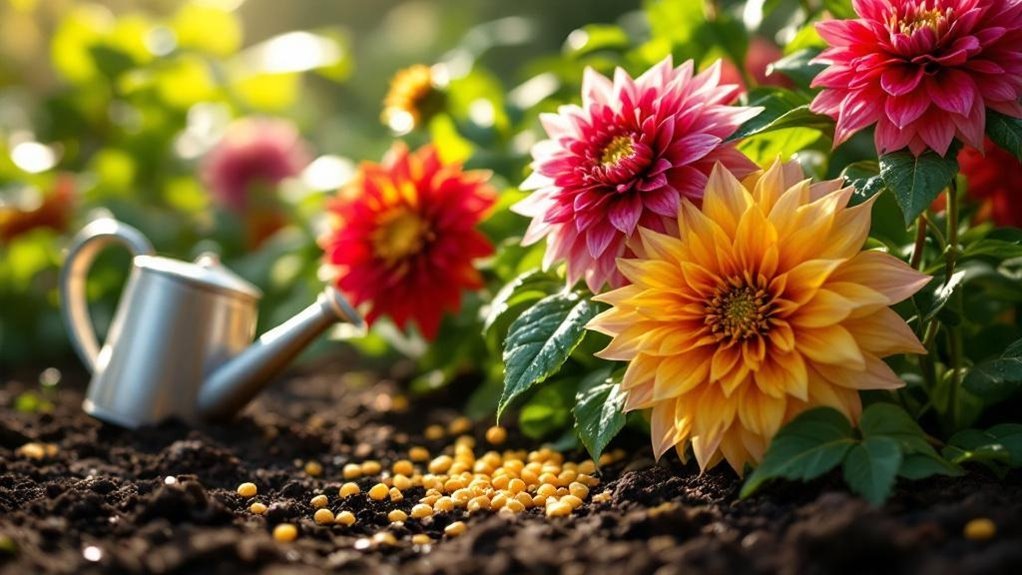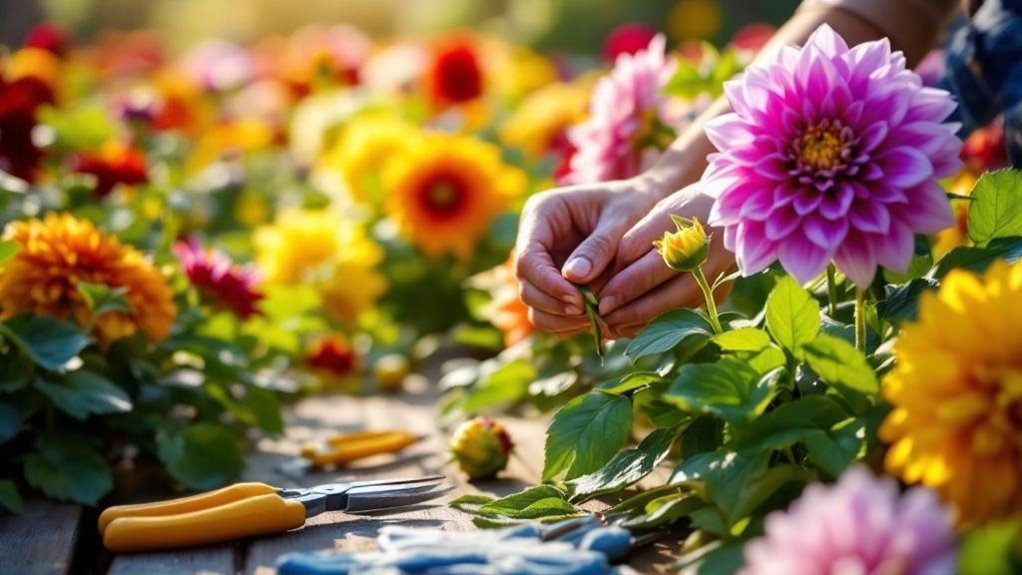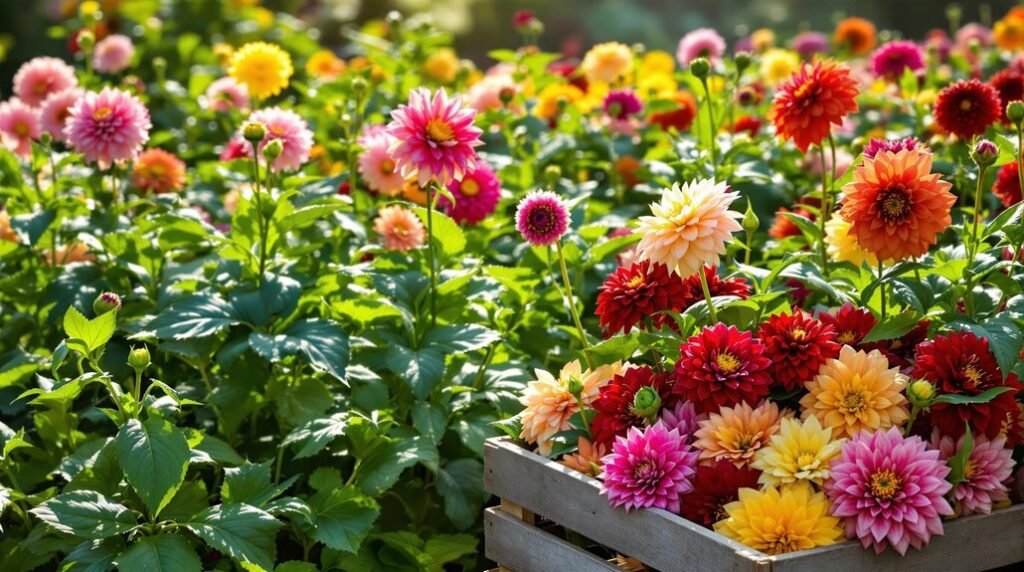Growing dahlias is like painting a living masterpiece—each choice affects the final bloom. If you want vibrant flowers that last all season, you need more than just planting tubers and watering occasionally. Proper soil preparation, timely pruning, and careful storage after frost are key steps that many gardeners overlook. Understanding these details can transform your garden, but there’s more to it than meets the eye.
Selecting and Preparing Dahlia Tubers
When selecting dahlia tubers, pick firm ones that have at least one visible “eye” or growth bud on the crown, as this guarantees they’ll bloom.
Avoid tubers that show signs of mold, wrinkles, or softness, since these indicate the tuber is unhealthy and not suitable.
Look closely for multiple growth buds; tubers with several eyes give your healthy dahlia a stronger start.
Buying from reputable growers helps guarantee your tubers are disease-free and robust.
Once you’ve selected suitable tubers, store them properly in a cool, dark place with stable humidity between 80–90% at 50–55°F to prevent damage and maintain their vigor.
Discard any “blind” tubers lacking visible growth buds—they won’t develop into flowering plants.
Ideal Soil and Planting Conditions
Rich, well-draining soil with a pH between 6.0 and 7.5 provides the perfect foundation for your dahlias to thrive.
Dahlias flourish best in rich, well-draining soil with a balanced pH of 6.0 to 7.5.
When growing dahlias, you want to plant tubers in soil that drains well to prevent rot and promote healthy root growth. Aim to plant tubers in late spring once soil temperatures reach around 60°F (15°C), ensuring successful sprouting.
Choose a sunny spot that gets 6 to 8 hours of direct sunlight daily, especially morning sun, to encourage vibrant blooms.
Space your dahlias 12 to 18 inches apart to allow good airflow and avoid overcrowding, reducing disease risk.
Raised beds are ideal soil setups for dahlias since they improve drainage and root health, giving your plants the best chance to flourish.
Watering and Fertilizing Guidelines

To keep your dahlias thriving in their ideal soil and sunlight, you’ll need to maintain consistent moisture levels. Aim to water about half an inch per week, preferably from the bottom with drip irrigation to prevent rot.
If you water overhead, do so early morning or late evening to reduce evaporation and fungal risks. Avoid watering during dormancy or cooler periods to prevent excess moisture buildup.
For fertilizing, apply a low-nitrogen liquid fertilizer every 3 to 4 weeks starting at sprouting to encourage healthy growth and blooming. Supplement with compost tea or fish emulsion every other week during active growth to supply crucial nutrients.
Monitoring soil moisture closely, especially in warm climates, guarantees your dahlias get the right balance of water and nutrients for vibrant blooms.
Light Requirements for Optimal Growth
Although dahlias can tolerate various light conditions, they need 6 to 8 hours of direct sunlight daily to thrive, with morning sun providing the best boost for growth.
To meet the light requirements for ideal growth, plant your dahlias in a spot that receives full sun, ensuring they soak up at least 6 to 8 hours of direct sunlight.
Dahlias need this consistent exposure to encourage strong stems, vibrant blooms, and healthy foliage.
In warmer climates, you might want to provide some afternoon shade to prevent overheating, but don’t compromise on their daily sun dose.
Pinching and Pruning Techniques

Once your dahlias have soaked up enough sunlight and grown to about 12 inches tall with several sets of leaves, it’s time to start pinching and pruning.
You should pinch them back by removing the center stalk when they’ve 4–5 sets of true leaves to encourage bushier growth and more flowers.
Regularly deadhead faded blooms to promote continuous blooming and keep your plants vigorous.
Use sharp, sanitized clippers to make clean cuts, reducing the risk of disease and supporting healthier growth.
Monitor growth carefully and adjust your pruning techniques to maintain good air circulation, preventing overcrowding.
Disbudding smaller buds can also help by redirecting energy to fewer, larger blooms, improving their size and quality throughout the season.
Supporting and Staking Dahlia Plants
When your dahlias start growing tall, especially larger varieties like dinner-plate types, you’ll need to stake them to keep the plants upright and prevent damage.
Start staking early in the growing season, soon after planting, to give your dahlias the support they need as they develop. You can use bamboo stakes for individual plants, making sure the stakes are tall enough to match the mature height.
For multiple plants, consider creating a support grid using T-posts and baling twine—the corral method keeps everything secure and upright.
Throughout the season, check your staking regularly and adjust ties or stakes to accommodate growth and avoid breakage. Proper support lets your dahlias thrive and showcase their stunning blooms without bending or snapping.
Managing Pests and Diseases
To keep your dahlias healthy and blooming, you need to stay vigilant against pests and diseases that can quickly damage buds and stunt growth.
Regularly check for pests like thrips and earwigs, using control measures such as traps and encouraging natural predators. Maintain a clean environment by clearing debris, which can harbor disease-causing pathogens.
Keep dahlias healthy by checking for thrips and earwigs, using traps, and clearing debris to prevent diseases.
Practice consistent watering practices—avoid overwatering to prevent root rot and underwatering to reduce plant stress and vulnerability. Preventative spraying with horticultural oil and castile soap helps reduce early pest populations and disease risk.
Watch for disease signs like galls or tuber rot and act immediately to stop spreading. By combining these strategies, you’ll effectively manage pest and disease threats, keeping your dahlias vibrant and flourishing throughout the growing season.
Harvesting Dahlias for Cut Flowers
Harvest dahlias for cut flowers in the early morning or late evening to keep blooms fresh and avoid heat stress.
When you harvest dahlias, use sharp, sanitized clippers to cut dahlias cleanly, then immediately place the stems in cool water to extend their vase life, which lasts about 7 days.
You’ll typically harvest dahlias about 90 days after you plant dahlias, with early bloomers flowering by mid-July and later varieties continuing until the first frost.
To encourage more blooms, regularly cut flowers throughout the growing season—this helps the plant produce additional flowers.
After cutting, condition your cut flowers by placing them in a cool, dark spot to hydrate before arranging them.
Following these steps guarantees you grow and care for dahlias that thrive as beautiful cut flowers.
Digging Up and Storing Tubers for Winter
Although the first frost kills the foliage, you should wait until this happens before digging up your dahlia tubers to prevent rot.
Once the frost has done its work, carefully lift the tubers with a garden fork or spade, avoiding damage. Don’t wash them; just shake off excess soil.
For proper storage:
- Store tubers in a cool, dry place at 50-55°F with 80-90% humidity to prevent desiccation.
- Inspect tubers regularly during winter, removing any showing rot or mold.
- In spring, wash and divide tubers, guaranteeing each piece has at least one viable eye for healthy growth.
Following these steps guarantees your tubers survive winter and thrive next season.
Choosing Popular Dahlia Varieties and Cultivars
After you’ve safely stored your dahlia tubers for winter, it’s time to think about which varieties will brighten your garden next season.
With your dahlia tubers safely stored, start planning next season’s vibrant garden varieties.
Dahlias, native to Mexico, offer around 60,000 named varieties, each producing gorgeous flowers in colors like white, pink, red, and purple.
If you’re a first time grower, popular dahlia varieties such as ‘Bishop of Llandaff’ with its dark foliage and red blooms, or ‘Miss Rose Fletcher’ with vibrant pink flowers, are excellent choices.
Consider flower forms too—cactus, peony, and waterlily types add variety to your garden. For small spaces, dwarf varieties like ‘Bonne Esperance’ bloom beautifully without taking up much room.
Use gardening tips from the National Dahlia Society to select cultivars that suit your style and climate.
Frequently Asked Questions
What Is the Secret to Growing Dahlias?
The secret to growing dahlias is giving them plenty of sunlight, well-draining soil, and consistent watering. You’ll want to plant tubers with eyes in warm soil, deadhead regularly, and watch for pests to keep them thriving.
Should I Cut off Dead Dahlia Blooms?
Think of dead dahlia blooms as spent chapters—you should cut them off to let new stories blossom. By regularly deadheading, you’ll redirect energy, encourage fuller growth, and keep your garden vibrant throughout the season.
How Do You Keep Dahlias Blooming All Summer?
To keep your dahlias blooming all summer, deadhead faded flowers regularly, water consistently, pinch center branches when they’re about 12 inches tall, apply low-nitrogen fertilizer every few weeks, and guarantee they get plenty of sunlight daily.
How to Properly Store Dahlias?
You’d think leaving dahlia tubers in the ground forever works, but no. After frost, gently lift them, store cool and dark with pine shavings, and check often to keep them happy till spring’s planting time.
Final Thoughts
By following these care tips, you’ll enjoy dahlias blooming beautifully all season long. Did you know a single dahlia plant can produce up to 30 vibrant flowers at once? Imagine your garden bursting with color and life! Keep your tubers healthy through proper storage, and your dahlias will reward you year after year. With attention to soil, water, and pests, you’re set to grow stunning dahlias that truly brighten any space.
